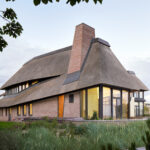A thatched roof is important for several reasons, spanning historical, environmental, aesthetic, practical, and socio-economic dimensions:
Historical and Cultural Significance
- Traditional Craftsmanship: Thatching is an ancient building method that has been used for thousands of years across various cultures. It represents a significant aspect of architectural heritage and cultural identity in many regions.
- Cultural Heritage: In many places, thatched roofs are an integral part of local history and traditions. Preserving thatched buildings helps maintain a tangible connection to the past.
Environmental Benefits
- Sustainable Materials: Thatching uses renewable resources such as straw, reeds, or palm leaves. These materials are biodegradable and have a minimal environmental footprint compared to synthetic alternatives.
- Energy Efficiency: Thatched roofs offer excellent insulation properties, helping to keep buildings warm in winter and cool in summer. This natural insulation reduces the need for artificial heating and cooling, thereby saving energy.
Aesthetic and Architectural Value
- Unique Appearance: Thatched roofs provide a distinctive, charming appearance that enhances the visual appeal of buildings. They are often associated with quaint, picturesque settings.
- Versatility: Thatch can be shaped to fit complex roof structures and curves, allowing for creative and flexible architectural designs.
Practical Advantages
- Durability and Longevity: When properly maintained, thatched roofs can last several decades. The longevity of thatched roofs has been proven over centuries of use.
- Natural Breathability: Thatch is a breathable material, which helps regulate moisture levels within a building and reduces the risk of dampness and mold.
- Weather Resistance: Thatch is highly effective at shedding water and insulating against temperature extremes, providing a comfortable living environment.
Socio-Economic Factors
- Employment and Skills Preservation: Thatching is a specialized skill that supports local employment and helps preserve traditional craftsmanship.
- Tourism and Economic Benefits: Thatched buildings often attract tourists, contributing to local economies by promoting cultural and heritage tourism.
Additional Benefits
- Acoustic Properties: Thatch has good acoustic properties, helping to dampen external noise and making the interior of buildings quieter and more serene.
- Use of Local Resources: Thatching typically utilizes locally available materials, supporting local agriculture and reducing transportation costs.
Modern Enhancements
- Fire Retardancy: Modern fire retardant treatments can be applied to thatched roofs, significantly improving their safety without compromising the traditional aesthetic.
- Improved Maintenance Techniques: Advances in maintenance and treatment methods have increased the longevity and durability of thatched roofs.
In summary, a thatched roof is important due to its blend of historical significance, environmental benefits, unique aesthetic qualities, practical advantages, and socio-economic contributions. It embodies a sustainable and culturally rich building practice that continues to be valued in many parts of the world.
The FIDDLER™ thatch roof tiles and accessories are reliable and have been used globally for over 10 years. The stone-coated metal roof tiles are manufactured per ISO 9001 standards. Best-in-class technology is used in the manufacturing process.

